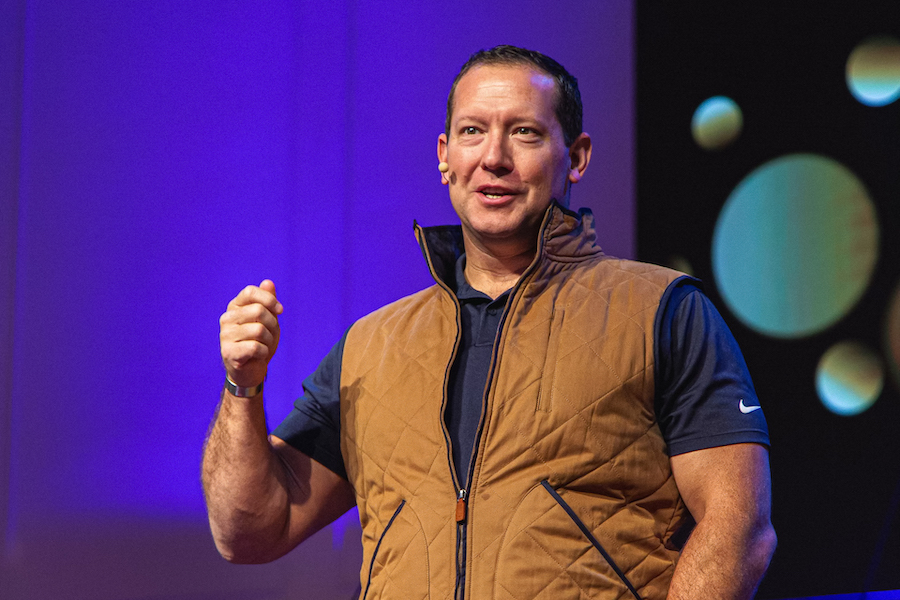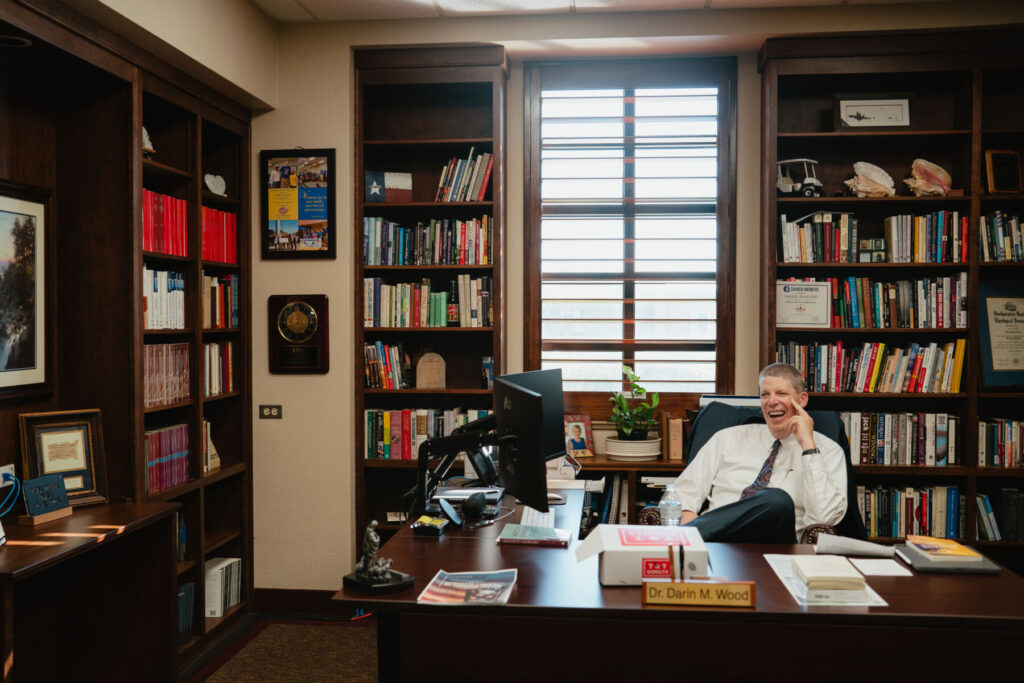The Family Fort: How the story of one family intertwines with Seminary Hill and global missions
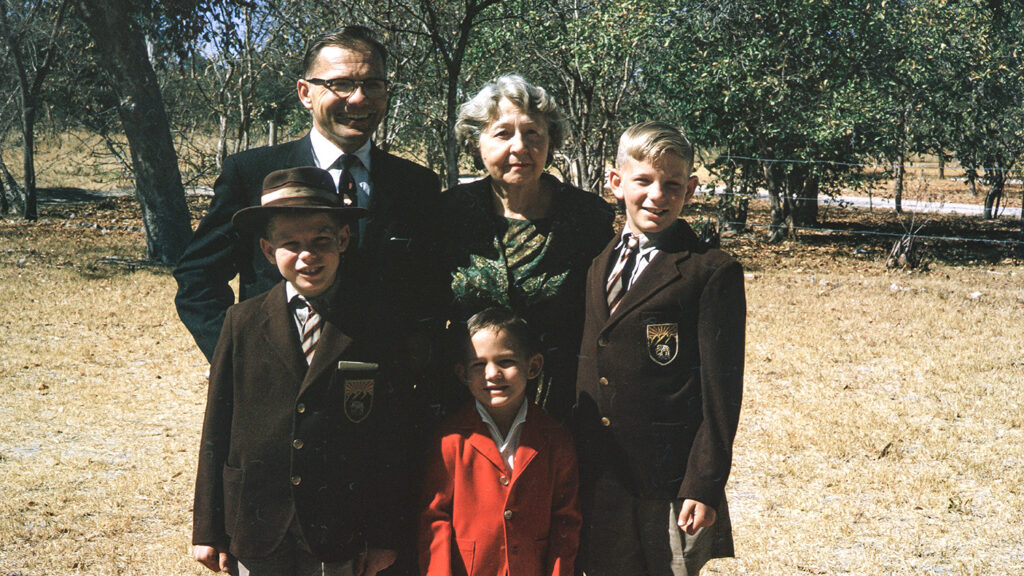

Editor’s note: The following feature story originally appeared in the spring 2021 issue of Southwestern News.
Unspeakable loss ended Alma Fort’s days at Southwestern Seminary. Her husband, Giles, a World War I veteran, had sensed a call to ministry, moving with his wife and toddler daughter into married student housing on the second floor of Barnard Hall in 1922. The couple had a son two years later.
Soon, though, Alma was widowed while pregnant with their third child.
The tuberculosis that Giles contracted during the war as a Navy dentist flared up when he and his wife, en route to a revival engagement, were caught in a blue norther—a swift cold front with strong winds that, in just minutes, can send temperatures tumbling 20 degrees or more.
The Navy arranged for Giles to recuperate in New Mexico, but the dry climate didn’t forestall a battle with double pneumonia that, in 1925, left his call to ministry unfulfilled.
Or did it?
Nearly 100 years ago, Alma Fort persevered, her grief abruptly compounded by a train wreck as she and the children were traveling with Giles’ body from New Mexico to Tuscaloosa, Alabama, for burial with his extended family. In the wreck, his casket fell from the railcar and broke open.
On a Sunday afternoon soon after her husband’s death, after the added trauma of the train wreck, and facing motherhood alone, Alma entered a church auditorium to pour out her heart to God while her young son, named Giles after his father, played with his preschool sister, Sarah.
“Lord, if you’ll just get me through this tough time so that I can put food on the table, a roof over their heads, and clothes on their back, I’ll raise this little boy to serve you,” she prayed, “and when you’re ready to use him, he’ll go with my blessing.”
During the Depression, Alma found work in Waco, Texas, as a banking clerk, walking to work each day, supporting not only her three children but, for a time, her mother and grandmother, who came to live in the home.
In 1953, Alma’s prayer came to fruition, as Milton Giles Fort Jr., who had served in World War II’s Pacific theater in the Navy, arrived in Rhodesia (now Zimbabwe) as a Southern Baptist missionary. He was a general practice graduate from the Baylor College of Medicine in Houston, and his wife, Wana Ann, was a pediatrician who had graduated second in her class from Baylor.
Mother and son shared Southwestern ties: Alma had been a seminary wife; Giles, in the 1940s, was a key part of the Baptist campus ministry at Texas A&M University that worked with Southwestern to launch a student missions conference that became an annual event, attended by grandson Gordon Fort when he was at A&M.
Years later, three of Alma’s five grandsons studied at Southwestern before heading to Africa as Southern Baptist missionaries in their parents’ footsteps. David took core courses required for appointment by the Foreign Mission Board (now International Mission Board) as a missionary surgeon; Gordon and Gregg earned Master of Divinity degrees to serve as church planters and, amid their overseas service, they also earned Doctor of Ministry degrees.
Alma Fort, in God’s providence, became the Fort family’s Southwestern “lynchpin,” as Gordon described it, producing more than 275 years of missions service.
Display of dedication
Giles and Wana Ann Fort, who served in Zimbabwe nearly 36 years, are honored in Mathena Hall’s Cooper Medical Missions Classroom along with Rebekah Naylor, longtime missionary doctor in Bangalore, India, and daughter of Robert E. Naylor, Southwestern’s fifth president (1958-1978), and missionary surgeon Bill Wallace, who was tortured and killed at the hands of Chinese communists in 1951.
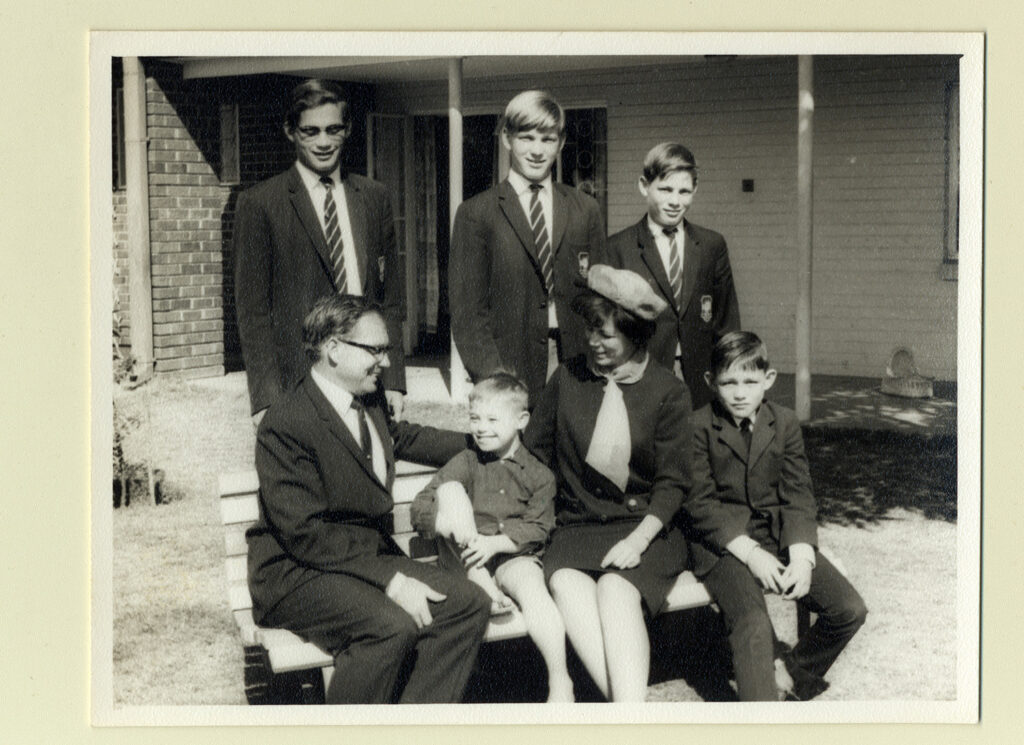
Among the memorabilia from the Forts displayed on one of the classroom’s walls are photos of the family, including David, Gordon, and Gregg along with the missionaries’ oldest son, Milton Giles Fort III, a retired gynecological oncologist with Louisiana State University in Baton Rouge, and youngest son Grady, with Down syndrome, who also lives in Baton Rouge and was raised on the mission field.
Photos of the Forts treating patients and interacting with believers in the African bush also are in the collection as well as a well-traveled suitcase, a native dress that was part of Wana Ann’s wardrobe, and a copy of her book, A Thousand Times Yes: Two Doctors Who Answered God’s Call, published in 2013 by New Hope Publishers, an affiliate of Woman’s Missionary Union. Her husband died the same year. She died two years later.
Gordon Fort, now the IMB’s senior ambassador for the president, was on hand for the classroom’s dedication after Mathena Hall opened in 2017. “Seeing the pictures of my parents and the memories that flood into my mind … it’s like the Lord is saying, ‘This is an example that needs to be followed.’ Mom would be the first one to say she wanted God to have the glory. She wanted people to see that two very ordinary people—in terms of their intellect, Mom and Dad were incredibly brilliant people in the medical field—but these were two servants who just said, ‘Lord, wherever you lead, I’ll go. Wherever you take me, I’ll trust you.’”
Family’s readiness
At the 1980 Southern Baptist Convention annual meeting in St. Louis, Giles and Wana Ann Fort and sons David and Gordon were the final speakers during Tuesday evening’s missions emphasis.
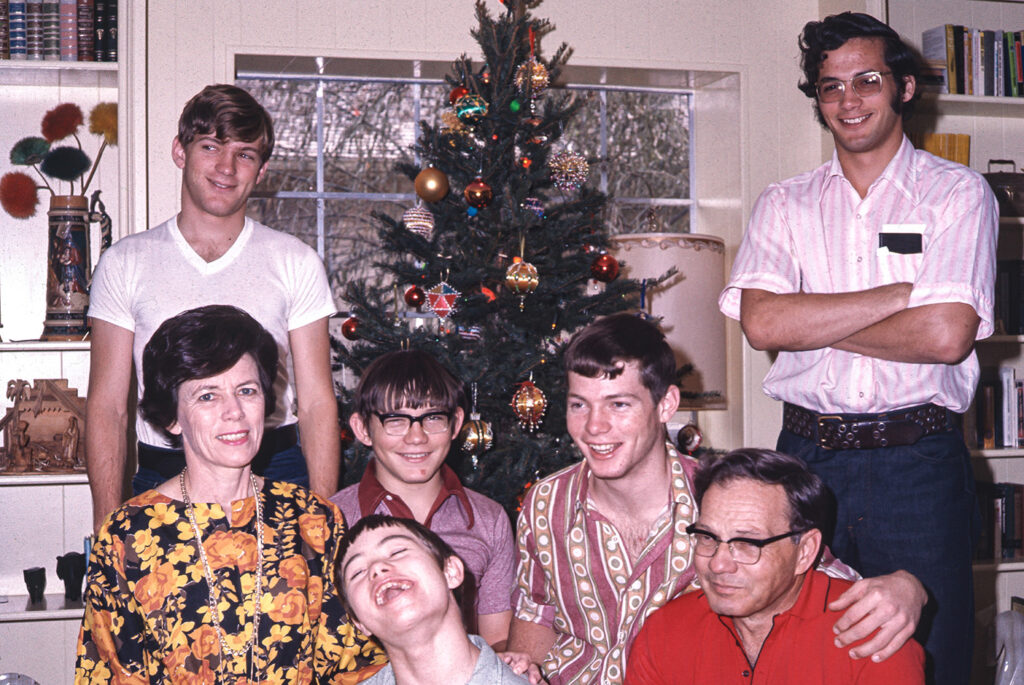
David, who was preparing for medical missions at the University of Texas Southwestern Medical School, spoke to his parents and to messengers in saying, “My understanding of God as loving, merciful, compassionate, and concerned for an entire world has developed not only from my personal experience with Him, but also from the understanding of Him … and this expression of Him in your lives.”
Gordon, then entering his third year of M.Div. studies at Southwestern, reflected on the possibility that “my parents might one day have to give their lives in the Lord’s service. But I am thankful our Lord knew the consequences of the decisions they would have to make” and that he can “trust my eternal Father to do with them what will serve His eternal purpose best.”
Wana Ann explained that warfare had escalated in Rhodesia as guerrilla movements fought to overthrow the government to gain Black-majority rule. A number of missionaries and local leaders had been killed, including fellow missionary Archie Dunaway one night in 1978 while the Forts were on furlough. And other missionaries evacuated the Sanyati station.
Still, “God’s call to me to go is as clear today as it was in the summer of 1943 when he first said ‘Go’” at a missions conference in Ridgecrest, North Carolina. “He’s never said ‘Stay.’” The Forts spent their last years of missionary service in Zimbabwe’s capital, Harare. “When I think of all He’s done for me, I can only respond with a ‘Yes,’” Wana Ann said. “He sends us back to minister to those who have suffered over there during these years of war in our troubled country. … Almost every family has had some kind of terrible suffering.”
Giles, in his message, underscored Southern Baptists’ Bold Mission Thrust initiative begun in the mid-1970s to share the Gospel with every person in the world by the year 2000. “God has given to Southern Baptists a vision of reaching a lost world for Him,” he said to the convention. “We must not fail, we must not let our vision be dimmed, we must not let anything take our eyes off the goal, because there are millions … waiting out there for us to fulfill the vision that God has given to us. We must make ready for the Lord’s return. We must see that everyone has an opportunity to know Him as Lord and Savior before He comes again.”
A mission unfolds
When the Forts’ intention to serve in China was altered by communism’s belligerence toward Christianity, an article in the Foreign Mission Board’s magazine, The Commission, stirred them toward Rhodesia in 1952. The writer, Ralph T. Bowlin, one of four missionaries in the country, mentioned their hope for establishing a hospital. One of the missionaries, he noted, “has more than she can cope with in regard to medical attention. She has not had any institutional medical training, but she has studied books, consulted medical authorities, and has depended upon wisdom from God.”
The Forts began Sanyati Baptist Hospital in a mud hut. An orange crate with a hot water bottle served as an incubator for premature babies. Over the years, the mission station grew to encompass a church, an 86-bed facility with a surgery wing, a midwifery school, elementary and high school, various missionaries, and a local staff. Each Sunday, Giles went out to preach in new places for planting the Gospel.
Alma came for a visit several times over the years, once as the honored guest when a new isolation ward opened at the hospital. Having retired in Harlingen, Texas, she was playing the organ at a Hispanic mission.
And there were the blessings and challenges of the Forts’ five sons.
Wana Ann, in her book A Thousand Times Yes, recounted, “Giles, being the oldest son, sought independence. David was concerned about excelling in everything and following the rules. Gordon was mischievous, but when he fully surrendered to the Lord, he had a complete turnaround. Gregg was a true African who mastered the language, whose frame of reference was completely based on Africa, and who became fully accepted by the people. And Grady was positive, happy, and had a trusting, childlike faith.”
The parents didn’t lessen their expectations of the two sons who later would enter Southwestern Seminary in their call to the ministry. “Good, better, best,” Gordon recalls. “Never let it rest until your good is better, and your better is best.” Gregg remembers his dad telling him, “Just because you’re going to preach doesn’t mean you can give up on physics and chemistry.” Though his father had no formal training in preaching, Gregg remembers his frequent exhortation, “You either put fire in your sermons or put your sermons in the fire. You need the Holy Spirit’s fire before you preach.”
Classes of consequence
Gordon, who had experienced the regimentation of a British boarding school since age 8, “will never forget the feeling” of his first days at Southwestern. “Having a class where studying the Bible was required, where learning Greek was required…. We’re praying before class, and I can go to a chapel, and we can sing and worship, I felt like I was in heaven.” And putting the principles he was learning into practice at the rural church he was pastoring “was just perfect for me.”
For Gregg, Southwestern’s influence was twofold: “One is my own spiritual formation and the other is the missions side. There were men on the spiritual formation side who spoke into my life and then there were the men who spoke into missions. They were incredibly brilliant but not so full of themselves that they could not be incredibly humble at the same time.”
Among them:
– Jack Gray, who taught spiritual formation and missions.
Gray, who traveled to Rhodesia to be the speaker for the missionaries’ annual meeting in the early 1970s, told of revival that had swept into Southwestern from the testimony of students from Asbury College and Seminary in Kentucky. “I can remember exactly where I was sitting in the auditorium,” Gordon said of the Sunday when he surrendered to God’s call in his mid-teens. “The Lord was stirring in my heart. When Dr. Gray was preaching I just sensed the Spirit of the Lord calling me to ministry.”
– Ebbie Smith, a missionary to Indonesia for 15 years before joining Southwestern’s faculty to teach missions.
“Ebbie would have us watch all these videos from cultures around the world,” Gregg said. Having minored in sociology and cultural anthropology in college, he gained valuable insight into “how the Gospel overlays all these cultures that I had studied.” Smith later traveled to the village in Zimbabwe where Gregg was based to work alongside him in evangelism and church planting during one Easter week.
– T.W. Hunt, a music faculty member who taught music in missions.
Gordon began to understand that “singing is an expression of the cultural and spiritual soul of a people. This had incredible implications in church planting and encouraging the indigenous development of a hymnology appropriate to the cultural forms and musical instruments of the people.” Hunt’s course also caused Gordon to ponder the structures of American churches versus those in Africa and ask, “Why do we build rectangular buildings for people who live in round huts?”
– Roy Fish, evangelism professor for whom Southwestern’s Fish School of Evangelism and Missions is named.
“Oftentimes he would open the door and walk in singing ‘Amazing Grace’ or one of the great hymns,” Gregg recounted of the sense of revival in Fish’s classes. “He’d say, ‘I just feel like worshiping.’… In the struggle we have with our flesh and our minds, he had asked God to let him go through even one day walking in the Spirit in total victory. I can hear him say, ‘I have known what it is to touch the hem of the garment for a day.’”
– Others credited by Gordon and/or Gregg for touching their lives and shaping their ministry included Justice Anderson, Earl Martin, and Cal Guy in missions; James Leo Garrett and Boyd Hunt in theology; Jack MacGorman, Curtis Vaughan, and Clyde Glazener in New Testament; David Garland in Old Testament and Hebrew; Scott Tatum in preaching; and Oscar Thompson in evangelism.
Yearning for prayer
Gordon also emerged from Southwestern with a lifelong passion for prayer, initially led to ask God, “Teach me to pray,” from the challenges he was facing as a young pastor in discipling new believers. Learning about an intercessory prayer ministry on campus, he became involved and was its leader for two years. A broom closet on campus was converted into a prayer room; a telephone line was installed for prayer requests and updates; and a Rolodex was kept for intercession by those who committed to regular times of prayer.
“God used that experience to help me in the years ahead in Africa when there was no other solution except to call on the Lord and ask Him to intervene,” Gordon said.
And it has continued as “the foundation stone” in various prayer initiatives he has leads IMB’s ambassador and, earlier, in two vice presidential roles.
Another enduring source of Gordon and Gregg’s gratitude to Southwestern is their Doctor of Ministry studies that undergirded their work on the mission field. Gordon’s project drew upon his initial work as a church planting catalyst in Botswana, titled “Initiating the Evangelization of the Kalanga People by Implementing a Coordinated Team Strategy to Plan Indigenous Churches.” Gregg’s project drew from spiritual warfare challenges he encountered soon after going to the field, titled “Training Churches in the Hurungwe District of Zimbabwe to Deal with Demonized Persons through a Contextualized Biblical Approach.”
“In our first baptismal service, three women out of 13 manifested a demonic spirit,” Gregg said. “I think every rural baptism that we went to there was some form of demonic manifestation—people who have professed their faith in Jesus Christ and yet, when they’re about to be baptized, these demonic spirits are manifested. So, you’ve got these questions, Where does it come from? Why does it manifest at baptism?”
Missions professor Ebbie Smith saw value in Gregg’s potential project. “You will get pushback and it will be difficult,” Smith said, “but I would encourage you to do it.” Returning to the field, Gregg began interviewing African traditional healers, Zimbabwean pastors, and fellow missionaries to hear their stories.
The project moved toward the concept of “demonization” for anyone, Christian or non-Christian, affected by ancestral spirits or other demonic forces. And it set forth a series of biblical lessons for churches to break the bondage and bring a person to freedom as part of salvation in order to eliminate any demonic manifestation at the sacred moment of baptism.
“It was an incredible journey. The D.Min. documentation is one of the most significant things in my missionary experience,” Gregg, now based in South Africa, said. “It still continues to find a voice and continues to find an outlet. So that’s been pretty remarkable.”
Staying on task
Gordon, who has returned to Southwestern several times as a chapel speaker, asked in one message, “Are you under the illusion this morning that God owed you the Gospel? Do you think that you have a right to hear the Gospel as many times as you want to, while there are those in our world who have never even heard it for the first time?”
Some might say the unreached are too far away, he commented.
“Listen, the distance from this school to the unreached is nothing compared to the distance that Jesus traveled from the right hand of His Father to a manger and to the cross.”
And some might shy away from being ridiculed or attacked.
“If you got up this morning and you thought to yourself, on my way to school I’m going to stop off at Krispy Kreme and share the Gospel with some guys there, and you knew that when you did, they’re going to throw a chair at you or smack you on the back of your head, how many times would you stop there? I’d start dragging my heels a little.”
The apostle Paul faced more serious questions, Gordon noted: “Who’s going to hit me with stones today? Am I going to get whipped again? Will I be shipwrecked? Will I be hungry? Will I be cold tomorrow?
“Why could Paul stay at his task? … Because he said, ‘When I proclaim the Gospel, something happens. It’s God’s power that draws people to salvation,’” Gordon said, drawing from Romans 1:16 and speaking in sync with what his parents, Giles and Wana Ann, spoke through their lives years earlier.
“It’s the power of God that changes the human heart.”
Fort urged Southwesterners in chapel that day to embrace any earthly loss and to say to God, “If there is anywhere, any place, any time that you can use me for the sake of your Kingdom, to share the message of hope with those who are lost, then God, before you ask me, I’ve already decided that my answer is going to be yes.
“Whatever it is. Wherever it is. Whenever it is.”
Art Toalston is a former editor of Baptist Press, now an independent writer in Nashville. He previously served as co-director of news and information at Southwestern Seminary, 1984, before joining the staff of the International Mission Board as a writer and editor.
